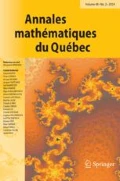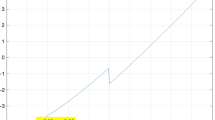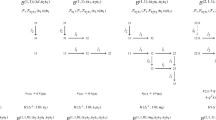Abstract
The classical Gauss problem of determining all imaginary quadratic number fields of class number one has an analogue involving finite motivic cohomology groups attached to the ring of integers \(o_F\) in a totally real number field \(F\). In the classical situation, the value of the zeta function of \(F\) at \(0\) can be written as a quotient of two—not necessarily coprime—integers, where the numerator is equal to the class number. For a totally real field \(F\) and an even integer \(n \ge 2\), the value of the zeta-function of \(F\) at \(1-n\) can also be written as a quotient of two—not necessarily coprime—integers, where the numerator is equal to the order \(h_n(F)\) of the motivic cohomology group \(H_\mathcal M ^2(o_F,\mathbb Z (n))\). This order is always divisible by \(2^d\), where \(d\) is the degree of \(F\). We determine all totally real fields \(F (\ne \mathbb{Q })\) and all even integers \(n \ge 2\), for which the quotient \(\frac{h_n(F)}{2^d}\) is equal to 1. There are no fields for \(n \ge 6\), there is only the field \(\mathbb{Q }(\sqrt{5})\) for \(n = 4\), and there are 11 fields for \(n=2\). The motivic cohomology groups \(H_\mathcal M ^2(o_F,\mathbb Z (n))\) contain the canonical subgroups \(WK^\mathcal M _{2n-2}(F)\), called motivic wild kernels, which are analogous to Tate–Shafarevic groups. For even integers \(n \ge 4\), there is again only the case \(n = 4\) and the field \(\mathbb{Q }(\sqrt{5})\), for which the motivic wild kernel \(WK^\mathcal M _{2n-2}(F)\) vanishes. However, for \(n=2\), among the totally real fields \(F\) of degrees between \(2\) and \(9\), we found 21 of them, for which \(WK^\mathcal M _{2}(F)\) vanishes, the largest degree being \(5\). A basic assumption in our approach is the validity of the \(2\)-adic Main Conjecture in Iwasawa theory for the trivial character, which so far has only been proven for abelian number fields (by A. Wiles).
Résumé
Un problème classique de Gauss a été de déterminer tous les corps de nombres quadratiques imaginaires ayant un nombre de classes égal à 1. Ce problème a un analogue pour les groupes de cohomologie motivique finis rattachés à l’anneau \(o_F\) des entiers algébriques d’un corps de nombres \(F\) totalement réel. Dans le cas classique, les valeurs de la fonction zêta de Dedekind évaluée en 0 peuvent s’écrire comme quotients de deux entiers, non nécessairement copremiers entre eux, et avec le numérateur égal au nombre de classes. Dans la situation d’un corps \(F\) totalement réel, avec \(n\) un entier pair \(\ge 2\), les valeurs de la fonction zêta de \(F\) en \(1-n\) peuvent s’écrire comme quotients de deux entiers, non nécessairement copremiers entre eux, mais avec le numérateur égal à l’ordre \(h_n(F)\) des groupes de cohomologie motivique \(H_\mathcal M ^2(o_F,{Z}(n))\). Ces ordres sont toujours divisibles par \(2^d\), où \(d\) est le degré de \(F\). Nous déterminons tous les corps de nombres \(F\) (\(\ne \mathbb Q \)) totalement réels, et tous les entiers pairs \(n\ge 2\), pour lesquels \(\frac{h_n(F)}{2^d}=1\). Il n’y a aucun corps pour \(n\ge 6\), il n’y a que le corps \(\mathbb Q (\sqrt{5})\) pour \(n=4\), et il y a 11 corps totalement réels pour \(n=2\). Les groupes de cohomologie motivique \(H_\mathcal M ^2(o_F,\mathbb Z (n))\) contiennent des sous-groupes canoniques \(WK^\mathcal M _{2n-2}(F)\), appelés noyaux sauvages motiviques, qui sont les analogues des groupes de Tate-Shafarevich. Pour les entiers pairs \(n\ge 4\), une fois de plus le noyau sauvage motivique \(WK^\mathcal M _{2n-2}(F)\) s’annule seulement pour le corps \(\mathbb Q (\sqrt{5})\) et pour \(n=4\). Cependant, pour \(n=2\), parmi les corps de nombres totalement réels \(F\) de degrés entre \(2\) et \(9\), nous en avons trouvé 21 pour lesquels \(WK^\mathcal M _{2}(F)\) s’annnule, le plus grand degré de ces corps étant \(5\). Une hypothèse de base de notre méthode est la validité de la conjecture principale 2-adique de la théorie d’Iwasawa, qui jusqu’à présent n’a été prouvée que pour les corps de nombres abéliens (par A. Wiles).
Similar content being viewed by others
References
Chinburg, T., Kolster, M., Pappas, G., Snaith, V.: Galois structure of \(K\)-groups of rings of integers. \(K\)-Theory 14(4), 319–369 (1998)
Diaz y Diaz, F.: Tables minorant la racine \(n\)-ième du discriminant d’un corps de degré \(n\). In: Publications Mathématiques d’Orsay 80, vol. 6. Université de Paris-Sud, Département de Mathématiques, Orsay (1980)
Friedlander, E., Suslin, A.: The spectral sequence relating algebraic \(K\)-theory to motivic cohomology. Ann. Sci. École Norm. Sup. (4) 35(6), 773–875 (2002)
Geisser, T.: Motivic cohomology over Dedekind rings. Math. Z. 248(4), 773–794 (2004)
Gillet, H., Soulé, C.: Filtrations on higher algebraic \(K\)-theory. In: Algebraic \(K\)-theory (Seattle, WA, 1997), pp. 89–148. Proc. Sympos. Pure Math., vol. 67. Amer. Math. Soc., Providence (1999)
Goldfeld, D.: Gauss’ class number problem for imaginary quadratic fields. Bull. Am. Math. Soc. 13, 23–37 (1985)
Gross, B., Zagier, D.: Heegner points and derivatives of \(l\)-series. Invent. Math. 84, 225–320 (1986)
Hesselholt, L., Madsen, I.: On the \(K\)-theory of local fields. Ann. Math. (2) 158(1), 1–113 (2003)
Hurrelbrink, J.: On the wild kernel. Arch. Math. 40(4), 316–318 (1983)
Jones, J., Roberts, D.P.: A database of local fields. J. Symb. Comput. 41(1), 80–97 (2006)
Kahn, B.: The Quillen-Lichtenbaum conjecture at the prime 2 (1997, preprint)
Klingen, H.: Über die Werte der Dedekindschen Zetafunktion. Math. Ann. 145, 265–272 (1961)
Kolster, M.: Higher relative class number formulae. Math. Ann. 323(4), 667–692 (2002)
Kolster, M.: \(K\)-theory and arithmetic. In: Contemporary developments in algebraic \(K\)-theory, ICTP Lect. Notes, XV, pp. 191–258 (electronic), Abdus Salam Int. Cent. Theoret. Phys., Trieste (2004)
Kolster, M., Movahhedi, A.: Galois co-descent for étale wild kernels and capitulation. Ann. Inst. Fourier 50(1), 35–65 (2000)
Lichtenbaum, S.: Values of zeta-functions, étale cohomology, and algebraic \(K\)-theory. In: Algebraic \(K\)-theory, II: “Classical” algebraic \(K\)-theory and connections with arithmetic (Proc. Conf., Battelle Memorial Inst., Seattle, Wash., 1972), pp. 489–501, Lecture Notes in Math., vol. 342. Springer, Berlin (1973)
Martinet, J.: Petits discriminants des corps de nombres. In: Number theory days (1980). (Exeter, 1980), pp. 151–193. London Math. Soc. Lecture Note Ser., vol. 56. Cambridge Univ. Press, Cambridge (1982)
Mazur, B., Wiles, A.: Class fields of abelian extensions of \({ Q}\). Invent. Math. 76(2), 179–330 (1984)
Mazza, C., Voevodsky, V., Weibel, C.: Lecture notes on motivic cohomology. In: Clay Mathematics Monographs, vol. 2. American Mathematical Society, Providence (2006)
Milne, J.S.: Étale cohomology. In: Princeton Mathematical Series, vol. 33. Princeton University Press, Princeton (1980)
Milnor, J.: Introduction to algebraic \(K\)-theory. In: Annals of Mathematics Studies, vol. 72. Princeton University Press, Princeton (1971)
Neukirch, J., Schmidt, A., Wingberg, K.: Cohomology of number fields, 2nd edn. Grundlehren der Mathematischen Wissenschaften [Fundamental Principles of Mathematical Sciences], vol. 323. Springer, Berlin (2008)
Odlyzko, A.M.: Discriminant bounds (1976, preprint)
Odlyzko, A.M.: Bounds for discriminants and related estimates for class numbers, regulators and zeros of zeta functions: a survey of recent results. Sém. Théor. Nombres Bordeaux (2) 2(1), 119–141 (1990)
Panin, I.A.: The Hurewicz theorem and \(K\)-theory of complete discrete valuation rings. Math. USSR-Izv. 29(1), 119–131 (1987)
The PARI Group, Bordeaux, PARI/GP, version 2.3.5 (2008)
Poitou, G.: Sur les petits discriminants. In: Séminaire Delange-Pisot-Poitou, 18e année: (1976/77), Théorie des nombres, Fasc. 1 (French), Exp. No. 6, 18 pp., Secrétariat Math., Paris (1977)
Rognes, J., Weibel, C.: Two-primary algebraic \(K\)-theory of rings of integers in number fields. J. Am. Math. Soc. 13(1), 1–54 (2000) (Appendix A by Manfred Kolster)
Serre, J.-P.: Local fields, Translated from the French by Marvin Jay Greenberg, Graduate Texts in Mathematics, vol. 67. Springer, Berlin (1979)
Siegel, C.L.: Berechnung von Zetafunktionen an ganzzahligen Stellen. Nachr. Akad. Wiss. Göttingen Math.-Phys. Kl. II 1969, 87–102 (1969)
Soulé, C.: \(K\)-théorie des anneaux d’entiers de corps de nombres et cohomologie étale. Invent. Math. 55(3), 251–295 (1979)
Stark, H.M.: A complete determination of the complex quadratic fields of class-number one. Michigan Math. J. 14, 1–27 (1967)
Stein, W., et al.: Sage Mathematics Software (Version 4.4.1), The Sage Development Team (2009)
Suslin, A., Voevodsky, V.: Bloch-Kato conjecture and motivic cohomology with finite coefficients. In: The arithmetic and geometry of algebraic cycles (Banff, AB, 1998), pp. 117–189. NATO Sci. Ser. C Math. Phys. Sci., vol. 548. Kluwer, Dordrecht (2000)
Tate, J.: Symbols in arithmetic. In: Actes du Congrès International des Mathématiciens (Nice, 1970), Tome 1, pp. 201–211. Gauthiers-Villars, Paris (1971)
Tate, J.: Relations between \(K_{2}\) and Galois cohomology. Invent. Math. 36, 257–274 (1976)
Voevodsky, V.: Triangulated categories of motives over a field, in Cycles, transfers, and motivic homology theories, pp. 188–238. Ann. Math. Stud., vol. 143. Princeton Univ. Press, Princeton (2000)
Voevodsky, V.: On motivic cohomology with \({ Z}/l\)-coefficients. Ann. Math. (2) 174(1), 401–438 (2011)
Voight, J.: Enumeration of totally real number fields of bounded root discriminant. In: Algorithmic number theory, pp. 261–281. Lecture Notes in Comput. Sci., vol. 5011. Springer, Berlin (2008)
Voight, J.: The Gauss higher relative class number problem. Ann. Sci. Math. Québec 32(2), 221–232 (2008)
Wagoner, J.B.: Continuous cohomology and \(p\)-adic \(K\)-theory. In: Algebraic \(K\)-theory (Proc. Conf., Northwestern Univ., Evanston, Ill., 1976), pp. 241–248. Lecture Notes in Math., vol. 551. Springer, Berlin (1976)
Washington, L.C.: Introduction to cyclotomic fields, 2nd edn. In: Graduate Texts in Mathematics, vol. 83. Springer, New York (1997)
Watkins, M.: Class numbers of imaginary quadratic fields. Math. Comp. 73(246), 907–938 (2004). (electronic)
Wiles, A.: The Iwasawa conjecture for totally real fields. Ann. Math. (2) 131(3), 493–540 (1990)
Author information
Authors and Affiliations
Corresponding author
Additional information
Dedicated to Paulo Ribenboim on the occasion of his 80th birthday
Rights and permissions
About this article
Cite this article
Junkins, C., Kolster, M. The analogue of the Gauss class number problem in motivic cohomology. Ann. Math. Québec 37, 79–108 (2013). https://doi.org/10.1007/s40316-013-0006-7
Received:
Accepted:
Published:
Issue Date:
DOI: https://doi.org/10.1007/s40316-013-0006-7




